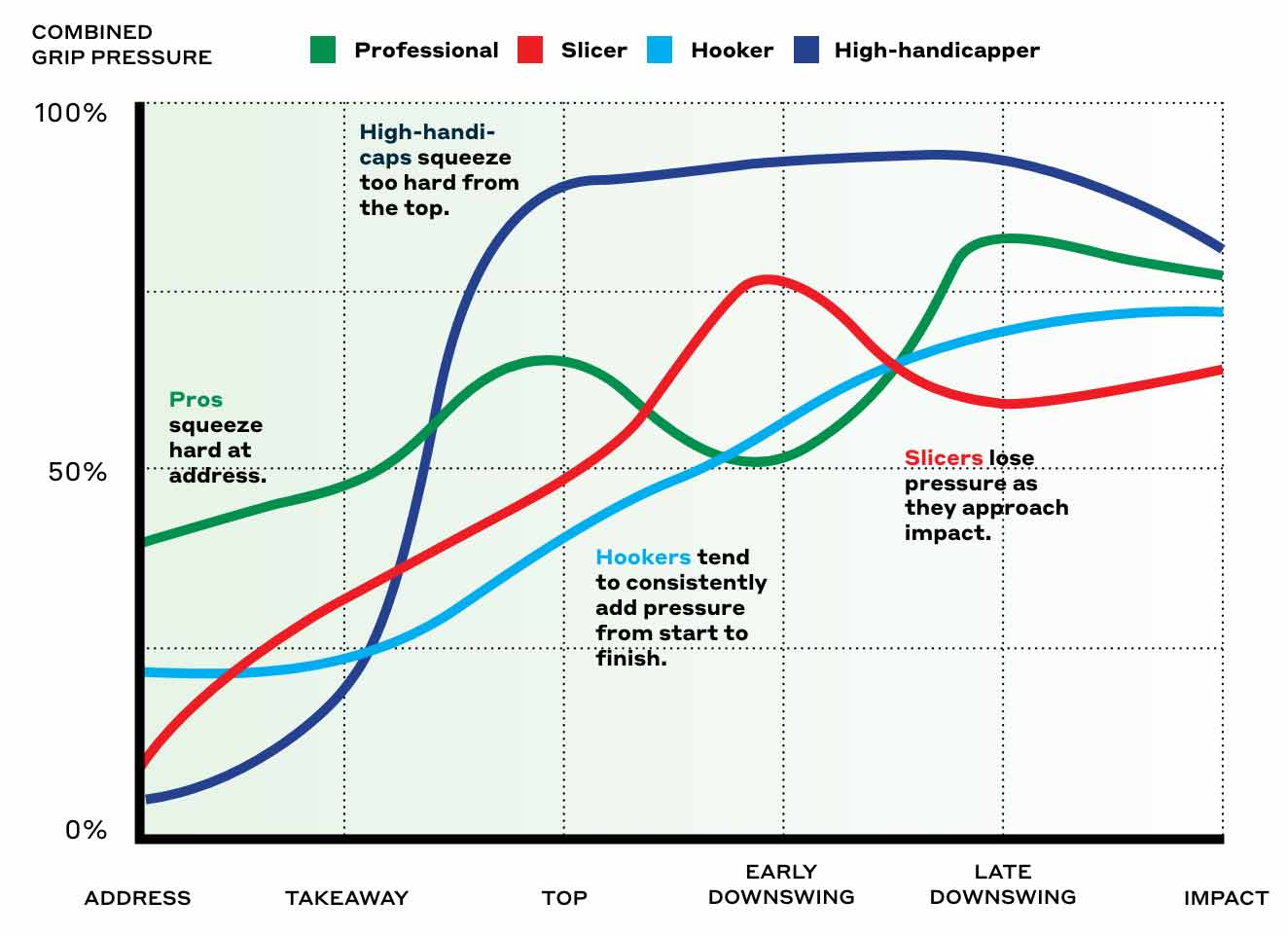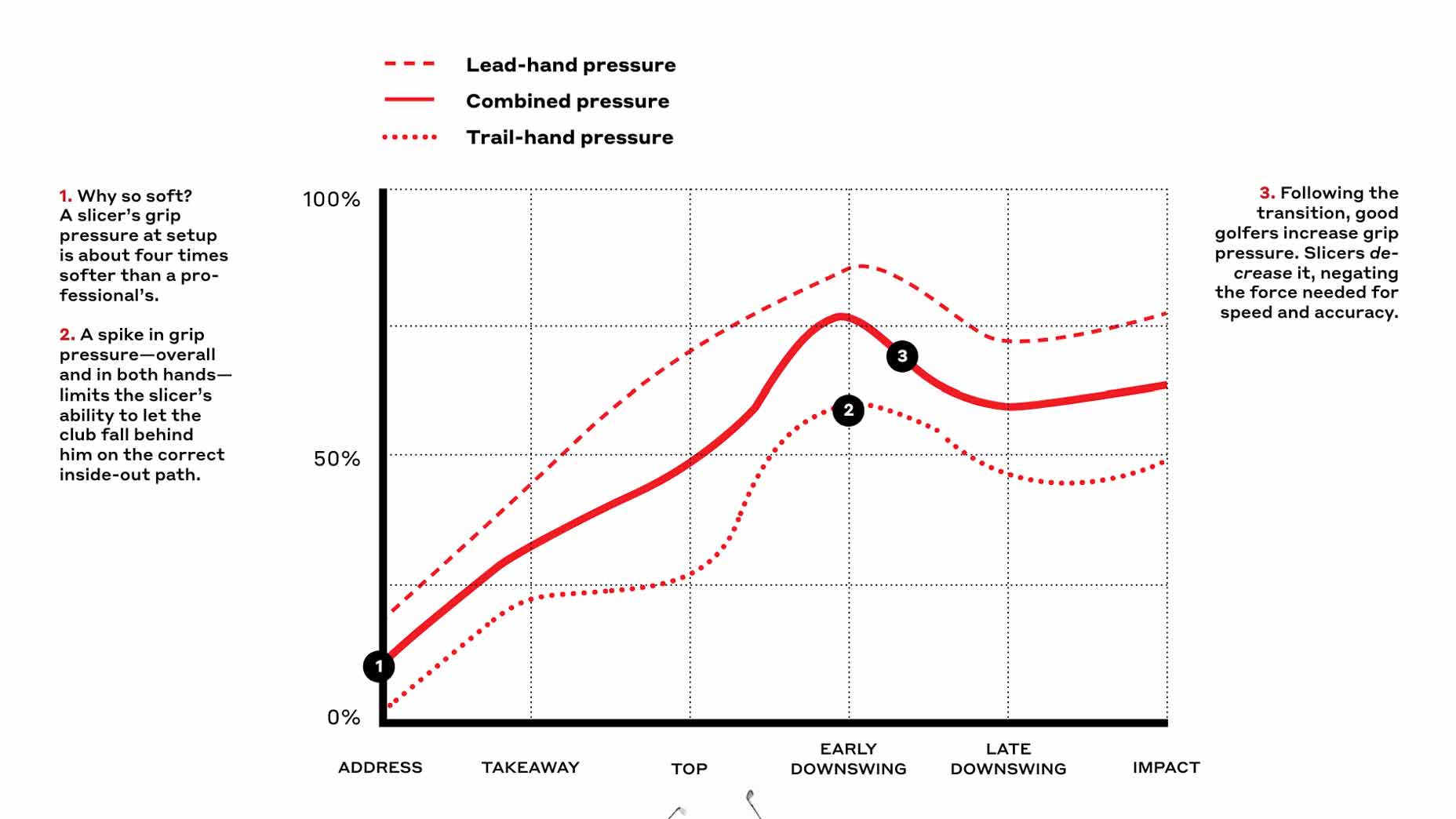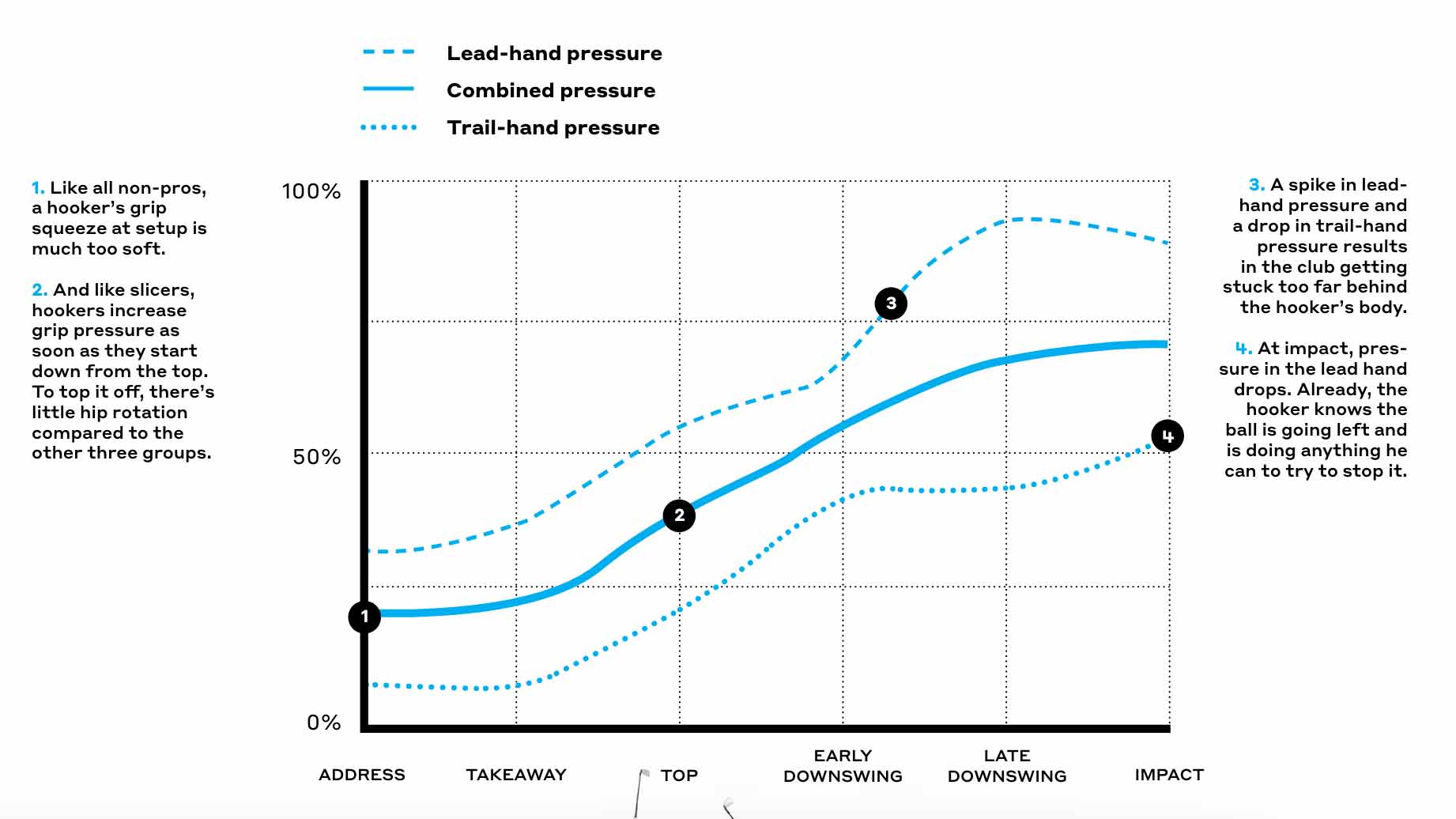


You may think how you hold the club is important, but our study shows that how tightly you grip is the real difference-maker.
Getty Images
You may think how you hold the club is important. (Actually, it is.) But our study shows that how tightly you wrap your mitts around the handle — or how lightly — is the real difference-maker.
We tested a dozen Tour pros, slicers, hookers and high-handicappers using special pressure-recording grips and found that how hard you squeeze at different parts of the swing is what separates good shots from the ones you’d like to forget. Too tightly? Too lightly? The answers, simply, are meaningful to finding the middle of the fairway or the green or looking for that lost Titleist in the fescue. This is not a story of grip it and rip it.
Read on to nix your bugaboo ballflight once and for all.
My team at the Golf Lab (thank you, Jonny Collins and Carson Hau) in Toronto analyzed the 7-iron swings of four different groups of golfers: 1) professionals, 2) slicers, 3) hookers and 4) high-handicappers, focusing solely on grip pressure at six key points in the swing. To collect the data we employed the services of a launch monitor, GEARS Motion Capture, a SwingCatalyst 3D Motion Plate and — most important — SensorGrips installed on premium LA Golf shafts (above). We captured full swings and those used for high and low pitch shots from 50 yards. As you can tell from simply glancing at the base results below, good golfers squeeze the handle much differently than most weekend players.

GOLF Magazine
1. Despite all the dynamics involved in the swing, pro golfers change total grip pressure the least from start to finish — just the way Tiger Woods has described it.
2. Pros squeeze the hardest at setup. This is especially impactful when you consider how much stronger a Tour player’s hands are compared to those in the general golf population.
3. Weekend players, in general, fail to squeeze the club hard enough at setup and in the early parts of the backswing.
4. Regardless of skill level, lead-hand grip pressure is, without question, the dominant force producer in the swing.

GOLF Magazine
The grip pressure profiles of the pros we measured in this study were incredibly consistent from player to player. As you can see in the graph above, pros squeeze the handle pretty hard at address [1]—nearly twice as hard as the members of the other groups (especially with the lead hand). Good golfers are known for being able to expertly control the clubface. Their ability to do so starts with a good squeeze even before they take the club back. The hard initial squeeze also matches up with the better player’s tendency to power their backswing using body rotation. They simply hold on and turn, whereas poor golfers tend to lift the club up with their hands and wrists, which probably explains why their grip pressure at setup is so low.
A pro ramps up the pressure as he reaches the top of the backswing [2]. These findings suggest that this first initial pressure peak is what allows the professional to efficiently stop his backswing without overswinging, laying the club off or crossing the line.
What’s interesting is that a pro’s grip pressure immediately drops as soon as he starts down [3]. This fuels what’s often described as the “magic move” rec golfers seek. Combining this pressure drop with body rotation (as in toward the target) is what gets the club on a power-rich plane, creating effortless speed.
Following the drop is a second pressure peak [4], about when the lead arm goes from parallel to the ground to impact. Dr. Sasho MacKenzie, one of golf’s leading biomechanists, teaches that the most efficient way to create force is to pull longitudinally along the shaft, “like you’re yanking the grip off the club.” The appearance of this second pressure peak supports his findings.
As a pro nears impact, his hand pressure remains noticeably stable [5], unlike the other groups who we found to either squeeze slightly harder or lighter as they swing through the ball — another reason better players are so good at controlling the clubface through impact.

GOLF Magazine
The lone solace you can take as a golfer who slices the ball is that you’re not alone! Slicers represent the largest segment of the golf population. Our study on grip pressure throughout the swing explains why so many are stuck with a nagging, extreme left-to-right ballflight. Trust me: There’s hope. The data shows that if you can adjust what you feel in your hands, from setup to impact, you can straighten your shots — and add yards — once and for all. But first, let’s see what you’re doing wrong.
Like all of the other non-pro groups we looked at in this study, slicers are guilty of gripping the club way too softly at address [1]. Sam Snead once said you should hold the handle “like you’re holding a little bird.” Keep in mind Sam had a grip harder than a miner’s handshake.
Another big revelation from our study is that slicers add far too much trail-hand pressure [2] as they start down from the top — the complete opposite of pro golfers, who ease grip pressure in this segment of the swing. Looking at this particular set of data points, and having coached hundreds of slicers, it’s this extra application of force from the trail hand that pushes the club off plane, resulting in an outside-in path and swipe across the golf ball.
Then, another mistake: After increasing grip pressure from the top of the backswing, slicers suddenly lose it mid-downswing (lead arm parallel to the ground), reducing the force applied to the club when it should be increasing [3].
The Fix: First, squeeze the club much harder with your left hand, not both hands. When it’s time for you to change direction from backswing to downswing, feel as though your righthand grip pressure relaxes, or let’s go, of the club. Start with slow rehearsal swings to get the right feel, then try some smooth 7-irons and slowly work your way to driver. In the end, it should feel like the club is falling behind you in your transition. Weird at first, but this is the secret to power and accuracy.

GOLF Magazine
When I first started coaching over 20 years ago, hooking the ball was a relatively uncommon problem for the golfing masses. Lately, however, my Top 100 Teacher colleagues and I are seeing more and more of it. The great line by Lee Trevino that “you talk to a fade but a hook won’t listen” remains true, but hookers can indeed take pride in that their grip pressure profile is the most similar to a pro’s than any other segment of the population. Just a few subtle changes will make all the difference in the world.
First, let’s address some problems. Like slicers and high-handicappers, a hooker’s squeeze at address is still much lower than a pro’s but not as low as most weekend golfer’s [1].
But in a similar fashion to a slicer’s swing, hookers tend to increase grip pressure as soon as they start down from the top [2]. (Recall that pros actually decrease grip pressure in this part of the swing, resulting in the “magic move.”)
Looking past the pressure data provided by the SensorGrips, our GEARS data on this particular subset of golfers showed that hookers generate the least amount of body rotation as they start down from the top. We’ll save that for another story.
Moving on: From lead arm parallel in the backswing to shaft parallel at impact, hookers really start to apply a ton of lead-hand pressure [3]. In my opinion, this is what causes the club to get even farther behind the golfer (like, way too inside-out). You now officially reside in Hook City.
To cap it off, hookers increase their trail-hand squeeze just before impact [4]. They sense they’re too inside-out, so they squeeze hard with the bottom hand in a last-ditch effort to square the face. What they get instead is a hook.
The Fix: Squeeze the handle a little harder with your lead hand at setup. Then, squeeze even harder as you make your backswing. As you transition from backswing to downswing, turn your hips faster toward the target while relaxing your lead hand and pushing with your trail hand. Goodbye, hook.

GOLF Magazine
Sorry, high-handicappers. The truth is, as it pertains to grip pressure, that you’re doing it all wrong— and backward! This really shouldn’t come as a surprise, but for the first time—thanks to our grip pressure data—you can learn how adjusting the feel in your hands can help you hit much better shots. To start, let’s talk about what’s causing your shotmaking misery.
First, your trail hand. High-handicappers are the only subset of golfers who apply more pressure with their trail hand than they do with the lead [1]. Again, totally backward.
Second, from halfway into the backswing all the way to impact, high-handicappers (as we found with the GEARS data) tend to hang on for dear life, forcing the club to move faster than the body. It’s the exact opposite of what a pro does, which, from top to impact, is to fire the body first (rotation) with the club responding in suit.
All that extra tension in the hands during the downswing [2] eventually causes the muscles in your upper body to tighten, preventing your ability to execute the proper sequencing (hips, shoulders, arms, club) and sapping needed clubhead speed.
Plus, extra trail-hand pressure [3] (on an order of roughly eight times what a pro uses) contradicts what most instructors, including me, have learned from Dr. MacKenzie, which is that the majority of force from late downswing into impact should be applied to the grip by the lead hand so it can pull it longitudinally into impact. (Again, like you’re ripping it off the shaft.) I repeat: wrong and completely backward.
The Fix: Squeeze the handle way harder with your lead hand and keep your trail hand relaxed. Throughout your backswing, try not to change your grip pressure in either. Set it at address, then maintain it. And just before you start down, relax your hands. This gives your body the chance to rotate and lead the club into impact instead of following it.
Liam Mucklow is a GOLF Top 100 Teacher and is the founder of the Golf Lab (mygolflab. com), headquartered in Toronto with 11 locations worldwide, including Liam’s base in Baton Rouge, La.